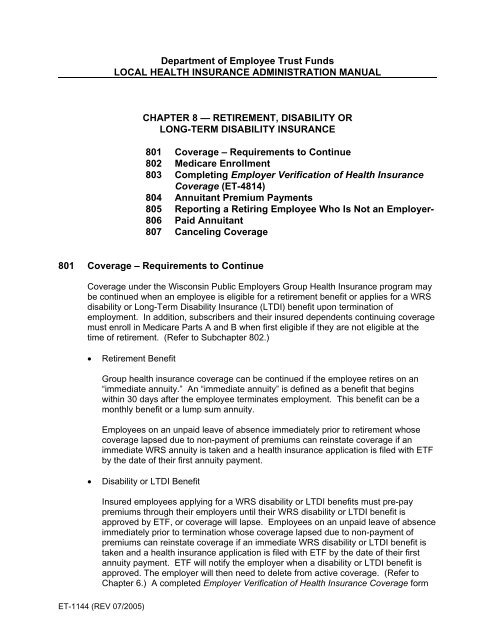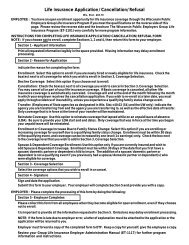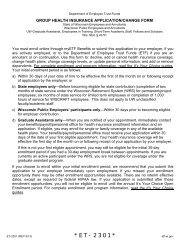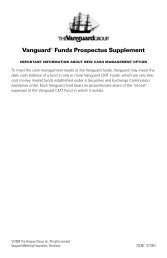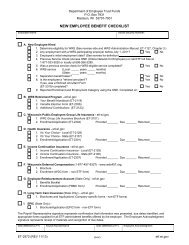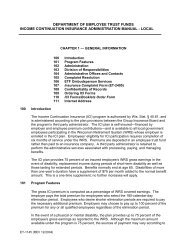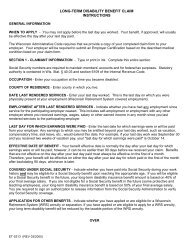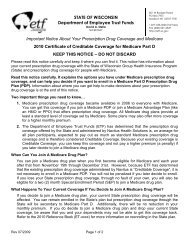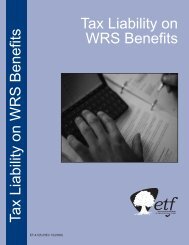Department of Employee Trust Funds LOCAL HEALTH ... - ETF
Department of Employee Trust Funds LOCAL HEALTH ... - ETF
Department of Employee Trust Funds LOCAL HEALTH ... - ETF
You also want an ePaper? Increase the reach of your titles
YUMPU automatically turns print PDFs into web optimized ePapers that Google loves.
<strong>Department</strong> <strong>of</strong> <strong>Employee</strong> <strong>Trust</strong> <strong>Funds</strong><br />
<strong>LOCAL</strong> <strong>HEALTH</strong> INSURANCE ADMINISTRATION MANUAL<br />
CHAPTER 8 — RETIREMENT, DISABILITY OR<br />
LONG-TERM DISABILITY INSURANCE<br />
801 Coverage – Requirements to Continue<br />
802 Medicare Enrollment<br />
803 Completing Employer Verification <strong>of</strong> Health Insurance<br />
Coverage (ET-4814)<br />
804 Annuitant Premium Payments<br />
805 Reporting a Retiring <strong>Employee</strong> Who Is Not an Employer-<br />
806 Paid Annuitant<br />
807 Canceling Coverage<br />
801 Coverage – Requirements to Continue<br />
Coverage under the Wisconsin Public Employers Group Health Insurance program may<br />
be continued when an employee is eligible for a retirement benefit or applies for a WRS<br />
disability or Long-Term Disability Insurance (LTDI) benefit upon termination <strong>of</strong><br />
employment. In addition, subscribers and their insured dependents continuing coverage<br />
must enroll in Medicare Parts A and B when first eligible if they are not eligible at the<br />
time <strong>of</strong> retirement. (Refer to Subchapter 802.)<br />
• Retirement Benefit<br />
Group health insurance coverage can be continued if the employee retires on an<br />
“immediate annuity.” An “immediate annuity” is defined as a benefit that begins<br />
within 30 days after the employee terminates employment. This benefit can be a<br />
monthly benefit or a lump sum annuity.<br />
<strong>Employee</strong>s on an unpaid leave <strong>of</strong> absence immediately prior to retirement whose<br />
coverage lapsed due to non-payment <strong>of</strong> premiums can reinstate coverage if an<br />
immediate WRS annuity is taken and a health insurance application is filed with <strong>ETF</strong><br />
by the date <strong>of</strong> their first annuity payment.<br />
• Disability or LTDI Benefit<br />
Insured employees applying for a WRS disability or LTDI benefits must pre-pay<br />
premiums through their employers until their WRS disability or LTDI benefit is<br />
approved by <strong>ETF</strong>, or coverage will lapse. <strong>Employee</strong>s on an unpaid leave <strong>of</strong> absence<br />
immediately prior to termination whose coverage lapsed due to non-payment <strong>of</strong><br />
premiums can reinstate coverage if an immediate WRS disability or LTDI benefit is<br />
taken and a health insurance application is filed with <strong>ETF</strong> by the date <strong>of</strong> their first<br />
annuity payment. <strong>ETF</strong> will notify the employer when a disability or LTDI benefit is<br />
approved. The employer will then need to delete from active coverage. (Refer to<br />
Chapter 6.) A completed Employer Verification <strong>of</strong> Health Insurance Coverage form<br />
ET-1144 (REV 07/2005)
Local Health Insurance<br />
Chapter 8 – Retirement, Disability or Long-Term Disability Insurance<br />
Page 2<br />
(ET-4814) is submitted to <strong>ETF</strong> at the time <strong>of</strong> the employee’s retirement or application<br />
for disability or LTDI benefit. (Refer to Subchapter 803 for instructions on how to<br />
complete the form.)<br />
• Termination With 20 Years <strong>of</strong> WRS Service, Not Taking Immediate Annuity<br />
Group coverage can be continued when terminating after age 55 (50 for protective<br />
category employees) and the employee has at least 20 years <strong>of</strong> creditable WRS<br />
service, even if an immediate retirement annuity is not taken. A Continuation –<br />
Conversion Notice (ET-2311) is completed and submitted to <strong>ETF</strong> at the time <strong>of</strong> the<br />
employee’s termination. (Refer to Subchapter 707 for instructions regarding this<br />
form.)<br />
For additional information, see the Group Health Insurance brochure (ET-4112) for<br />
retired employees.<br />
802 Medicare Enrollment<br />
Active employees and their insured dependents eligible for coverage under the Federal<br />
Medicare program may defer enrollment under Medicare Part A (hospital) and Part B<br />
(medical) until the employee terminates employment or health insurance coverage as an<br />
active employee ceases.<br />
Annuitants and insured dependents who are eligible for coverage under the Federal<br />
Medicare program must enroll in Parts A and B when first eligible due to age or disability<br />
per Wis. Stats. § 40.51(7) and 40.52(2). Annuitants and insured dependents failing to<br />
enroll in Medicare will be held responsible for the portion <strong>of</strong> claims that Medicare would<br />
have covered, had they been enrolled in Medicare. Failure to enroll in Medicare at the<br />
next enrollment opportunity may result in termination <strong>of</strong> coverage in the Group Health<br />
Insurance program.<br />
A Medicare Eligibility Statement (ET-4307) is used to inform <strong>ETF</strong> <strong>of</strong> the Medicare<br />
effective dates. <strong>ETF</strong> will mail the Medicare Eligibility Statement to the retiree for<br />
completion. A sample <strong>of</strong> the Medicare Eligibility Statement appears at the end <strong>of</strong> this<br />
subchapter. Please provide <strong>ETF</strong> with a copy <strong>of</strong> the retiree’s Medicare card, when<br />
available.
Medicare Eligibility Statement (ET-4307)<br />
Local Health Insurance<br />
Chapter 8 – Retirement, Disability or Long-Term Disability Insurance<br />
Page 3
Local Health Insurance<br />
Chapter 8 – Retirement, Disability or Long-Term Disability Insurance<br />
Page 4<br />
803 Completing Employer Verification <strong>of</strong> Health Insurance Coverage (ET-4814)<br />
An Employer Verification <strong>of</strong> Health Insurance Coverage must be submitted to <strong>ETF</strong> for<br />
each employee regardless <strong>of</strong> whether the employee plans to continue health coverage<br />
after retirement. The form is required, even when the employer is paying all or part <strong>of</strong> an<br />
annuitant’s monthly health premium. An insured employee receives the form with the<br />
retirement application from <strong>ETF</strong>. The form is also required for a surviving<br />
spouse/dependent <strong>of</strong> a deceased insured employee or employer-paid annuitant. The<br />
employee or survivor completes the top portion <strong>of</strong> the form and submits to the employer.<br />
Employer Instructions - Complete the Employer Section <strong>of</strong> the form reflecting the<br />
coverage as <strong>of</strong> the date employment terminates:<br />
1. Check the appropriate box for coverage verification:<br />
a. Coverage verified is in effect; or<br />
b. Coverage verified is not yet in effect but employee has submitted a health<br />
insurance application to change coverage. (Advise employee to submit a<br />
Group Health Insurance Application (ET-2301) with the Employer<br />
Verification <strong>of</strong> Health Insurance Coverage form if coverage will change<br />
when coverage as an active employee ceases.)<br />
2. Plan - The name <strong>of</strong> the health plan.<br />
3. Five-digit Group Number - The first digit <strong>of</strong> the group number is 7, followed by the<br />
four-digits preceding the “-000” in your EIN (e.g., 79999).<br />
4. Coverage Type - Indicate Single or Family coverage.<br />
5. Monthly Premium Rate - Enter the full monthly premium rate – TOTAL OF<br />
EMPLOYEE AND EMPLOYER CONTRIBUTIONS. Refer to the current It’s Your<br />
Choice booklet (ET-2128).<br />
6. Enter the month, day (the last day <strong>of</strong> the month) and year through which health<br />
insurance coverage is paid as an active employee.<br />
7. Indicate whether premiums will be paid by the employer after termination: “Yes”<br />
or “No.”<br />
8. Name <strong>of</strong> Employer.<br />
9. Employer Number - The number given to employers beginning with 69-036.<br />
Enter the last seven digits <strong>of</strong> the number (e.g., 69-036-9999-000).<br />
10. Date - Enter the current date.<br />
11. Signature <strong>of</strong> Employer Representative - Signature <strong>of</strong> the employer representative<br />
completing the form.
Local Health Insurance<br />
Chapter 8 – Retirement, Disability or Long-Term Disability Insurance<br />
Page 5<br />
12. Telephone Number - The telephone number <strong>of</strong> the employer representative who<br />
completed the form.<br />
Return the top two plies to the employee. Keep the bottom ply for your records. The<br />
employee must submit the form to <strong>ETF</strong> after completing the employee portion. A sample<br />
<strong>of</strong> the Employer Verification <strong>of</strong> Health Insurance Coverage form appears at the end <strong>of</strong><br />
this subchapter.
Local Health Insurance<br />
Chapter 8 – Retirement, Disability or Long-Term Disability Insurance<br />
Page 6<br />
Employer Verification <strong>of</strong> Health Insurance Coverage (ET-4814)
Local Health Insurance<br />
Chapter 8 – Retirement, Disability or Long-Term Disability Insurance<br />
Page 7<br />
804 Annuitant Premium Payments<br />
Annuitant premium payments are made through one <strong>of</strong> the following methods:<br />
A. Employer-Paid Annuitant--Premiums are paid to <strong>ETF</strong> by the employer when the<br />
employer pays any portion <strong>of</strong> the premium for the annuitant. (Refer to Chapter 6<br />
for reporting employer-paid annuitant health coverage.)<br />
B. Annuity Deduction—Premiums are paid from a monthly retirement or disability<br />
annuity if the annuity is sufficient to cover the entire premium and no portion <strong>of</strong><br />
the premium is being paid by the employer;<br />
C. Direct Pay—When the annuity is not sufficient to cover the entire premium, the<br />
health plan will directly bill the annuitant and the annuitant will pay premium<br />
directly to the health plan.<br />
D. Group Life Insurance Conversion—This program, governed by Wis. Stat.<br />
§ 40.72(4r) and Wis. Admin. Code § <strong>ETF</strong> 60.60, allows eligible employees to<br />
convert their group life insurance to pay health insurance premiums. For more<br />
information, see the Converting Your Group Life Insurance to Pay Health or<br />
Long-Term Care Insurance Premiums brochure (ET-2325).<br />
805 Reporting a Retiring <strong>Employee</strong> Who Is Not an Employer-Paid Annuitant<br />
A retiring employee who qualifies to continue health insurance coverage is reported on<br />
the Monthly Deletions Report (ET-2612) and Monthly Coverage Report for active<br />
employees for that health plan. (Refer to Chapter 5 for instructions.) In this situation, an<br />
Employer Verification <strong>of</strong> Health Insurance Coverage form (ET-4814) must be submitted<br />
to <strong>ETF</strong>.<br />
806 Canceling Coverage<br />
At the time <strong>of</strong> retirement, health insurance can be canceled by indicating “No” on the<br />
Employer Verification <strong>of</strong> Health Insurance Coverage form (ET-4814) where asked if the<br />
employee wishes to continue health insurance. Following retirement, the insured<br />
annuitant must submit written notification to <strong>ETF</strong> to cancel coverage. Refer to the It’s<br />
Your Choice booklet (ET-2128) for more information.


